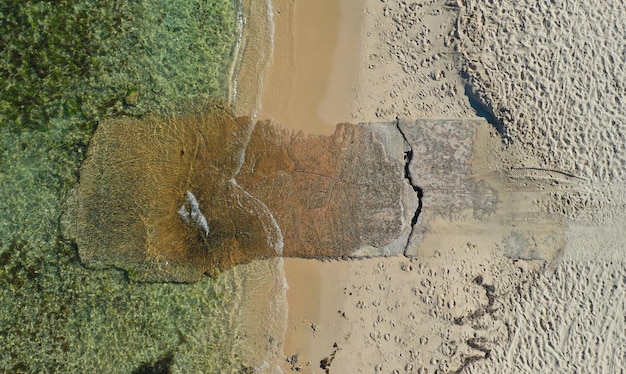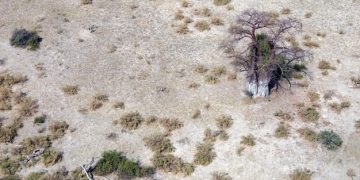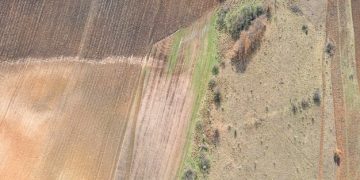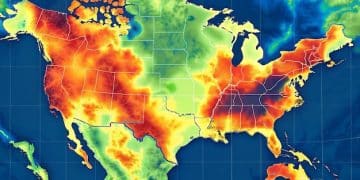US water resources: Climate change impacts by 2030

By 2030, climate change is projected to significantly alter US water resources, leading to increased scarcity in some regions, heightened flood risks in others, and widespread impacts on water quality, agriculture, and ecosystems through shifts in precipitation patterns, snowpack dynamics, and rising temperatures.
The intricate web of life, industry, and agriculture across the United States hinges on a stable and predictable water supply. Yet, as global climate patterns continue their unsettling shift, a pivotal question emerges: What are the Projected Impacts of Climate Change on US Water Resources by 2030? This inquiry is not merely academic; it delves into the fundamental availability and quality of one of our most precious resources, demanding a meticulous examination of the challenges and potential adaptations lying just ahead.
The evolving hydrologic cycle and its shifts
The Earth’s hydrologic cycle, a fundamental process regulating water movement, is profoundly sensitive to climate shifts. Changes in temperature, precipitation patterns, and atmospheric conditions directly influence how water circulates between the land, oceans, and atmosphere. By 2030, we anticipate several significant alterations to this cycle across the United States, impacting everything from local precipitation to major river flows.
One of the most evident transformations is the increasing unpredictability of precipitation. While some regions might experience more intense rainfall events, leading to elevated flood risks, others are projected to face prolonged periods of drought. This variability complicates water management strategies, as historical averages become less reliable for future planning. The timing and intensity of rainfall events are crucial, influencing soil moisture, runoff, and groundwater recharge.
Changing precipitation patterns
The distribution of rainfall and snowfall is not uniform across the US, and climate change is intensifying these regional differences. The arid western states are likely to see further reductions in snowpack and earlier melting, which dramatically affects river flows during critical agricultural seasons. Conversely, parts of the Midwest and Northeast could experience more frequent and heavy downpours.
- Increased extreme precipitation events in the East and Midwest.
- Decreased overall precipitation in the Southwest, exacerbating aridity.
- Shifts in seasonal precipitation, impacting growing seasons for agriculture.
These changes directly influence surface water availability. Rivers and lakes are the primary sources for municipal water supplies, irrigation, and energy production. Reduced snowpack in mountainous regions, for instance, means less natural reservoir storage for summer months when demand is highest. The consequences extend beyond mere volume; the timing of water availability is equally critical for ecosystems and human activities alike.
Impact on snowpack and runoff
Snowpack serves as a natural reservoir, slowly releasing water as it melts throughout spring and summer. Warmer temperatures are already leading to earlier snowmelt and a reduction in the overall snow-covered area. This phenomenon means that a significant portion of water, historically stored in solid form, returns to the system much earlier in the year. The result is often an increased risk of spring flooding followed by severe water scarcity later in the summer.
The earlier runoff can overwhelm existing infrastructure designed for different flow regimes. Water managers face the dual challenge of capturing and storing this earlier pulse of water and then managing prolonged periods of reduced flow. This scenario has profound implications for hydroelectric power generation, agricultural irrigation, and the health of aquatic ecosystems that rely on consistent cold water flows during the warmer months. Managing these new patterns requires innovative storage and distribution solutions, moving beyond historical assumptions.
This evolving hydrological landscape necessitates a re-evaluation of current water infrastructure and management practices. From reservoir operations to urban planning, adapting to these shifts is paramount. The interconnectedness of water systems means that changes in one region, like reduced snowpack in the Rockies, can have cascading effects on downstream states, highlighting the need for collaborative, long-term strategies to ensure water security across the nation by 2030 and beyond.
Water scarcity and intensified droughts
The specter of water scarcity is perhaps one of the most immediate and tangible threats posed by climate change to US water resources. While drought is a natural phenomenon, its frequency, intensity, and duration are being exacerbated by a warming climate. By 2030, many regions, particularly the already arid and semi-arid parts of the United States, are projected to experience more severe and persistent drought conditions, leading to significant challenges for communities, agriculture, and ecosystems.
The primary driver behind this intensified scarcity is a combination of reduced precipitation in some areas, increased evaporation due to higher temperatures, and altered snowpack dynamics. As temperatures rise, more water evaporates from reservoirs, lakes, and soil surfaces, reducing net available water even if precipitation levels remain constant. This evaporative loss, sometimes referred to as “thirsty air,” amplifies the effects of dwindling rainfall.
Regions at highest risk
The American Southwest, including states like California, Arizona, Nevada, and parts of Utah and New Mexico, stands out as being particularly vulnerable. This region already faces chronic water supply challenges, relying heavily on diminishing snowpack from the Rocky Mountains and the over-allocated Colorado River. Projections indicate further declines in runoff and increased demand, pushing these systems to their breaking point.
Beyond the Southwest, other areas are also at significant risk. Parts of the Great Plains and the Southeast, while not traditionally considered arid, could experience more frequent “flash droughts” – rapid onset droughts driven by high temperatures and reduced soil moisture. These events can devastate crops and strain local water supplies with little warning, requiring swift and often costly responses.
- Southwest US: Decreased Colorado River flows, reduced reservoir levels.
- California’s Central Valley: Increased reliance on dwindling groundwater.
- Great Plains: Higher risk of agricultural losses due to drought.
Impact on agriculture and industry
Agriculture, a cornerstone of the US economy, is profoundly dependent on reliable water supplies. Drought conditions directly threaten crop yields, livestock health, and farm income. Farmers may face difficult choices between fallowing land, investing in expensive irrigation technologies, or shifting to less water-intensive crops. The current practices, often designed around past climate patterns, may prove unsustainable in the face of persistent water scarcity by 2030.
Industries that rely heavily on water for cooling, processing, or sanitation will also face significant challenges. Energy production, including thermometric power plants and some renewable energy facilities, requires substantial water volumes. Manufacturing plants may experience disruptions or increased operational costs due to water restrictions. This interconnectedness means that water scarcity impacts reverberate through the entire economy, affecting supply chains and consumer prices. Adapting to these looming shortfalls will require concerted efforts in water conservation, efficiency improvements, and the exploration of alternative water sources, alongside robust policy frameworks to allocate increasingly scarce resources effectively.
Increased flood risks and water quality degradation
While some regions of the US grapple with drought and scarcity, others are predicted to face the contrasting challenge of increased flood risks, often alongside significant degradation of water quality. These seemingly opposite impacts are both direct consequences of a changing climate, primarily driven by more intense precipitation events, rising sea levels, and altered hydrological dynamics. By 2030, these combined threats will pose substantial challenges to infrastructure, human health, and ecological systems.
The underlying cause of increased flooding is the greater energetic capacity of a warmer atmosphere to hold and then release moisture. This translates into more frequent and heavier rainfall events, even in areas where overall annual precipitation might not significantly change. These intense downpours can overwhelm existing stormwater drainage systems, leading to urban flooding, and cause rivers to swell rapidly, leading to flash floods and riverine inundation.
Coastal and riverine flooding
Coastal areas are particularly vulnerable to a combination of rising sea levels and more intense storm surges. As global temperatures climb, ocean waters expand, and melting glaciers and ice sheets contribute to rising sea levels. By 2030, this will mean more frequent “sunny day” flooding in low-lying coastal communities, disrupting daily life and damaging property. Furthermore, when intense rainfall coincides with high tides or storm surges, the risk of severe coastal flooding dramatically increases, impacting critical infrastructure like ports, wastewater treatment plants, and transportation networks.
Riverine flooding, caused by excessive rainfall over inland areas, is also on the rise. Changes in snowmelt patterns, as discussed earlier, can contribute to earlier and more rapid peak flows. Land-use changes, such as increased urbanization and deforestation, exacerbate this by reducing natural absorption, leading to faster runoff into river systems. This combination of climatic and anthropogenic factors intensifies flood potential.
- Increased “sunny day” flooding in major coastal cities like Miami and New Orleans.
- Greater frequency of intense rainfall events leading to urban flash floods.
- Higher risk of river overflowing its banks in regions with altered rainfall patterns.
Water quality degradation
The increase in flood events directly contributes to water quality degradation. Flooding can overwhelm wastewater treatment plants, leading to raw sewage overflows. It can also pick up contaminants from agricultural fields (pesticides, fertilizers), industrial sites (heavy metals, chemicals), and urban areas (oil, trash), carrying them into rivers, lakes, and ultimately, drinking water sources. This influx of pollutants can render water unsafe for consumption and recreational activities, threatening public health.
Moreover, rising water temperatures themselves can degrade water quality. Warmer water holds less dissolved oxygen, which is critical for aquatic life. It also promotes the growth of harmful algal blooms (HABs), which can produce toxins dangerous to humans and animals, and lead to dead zones in water bodies. Changes in stream flow — both excessive and insufficient — affect the natural dilution and self-purification capacity of water bodies. The interconnectedness of flood risk and water quality means that mitigation efforts must address both quantity and purity, safeguarding not only infrastructure but also the fundamental health of water ecosystems and the communities that depend on them.
Impacts on ecosystems and biodiversity
The health of freshwater ecosystems is intrinsically linked to the quantity, quality, and timing of water flows. Climate change, by altering these fundamental hydrological parameters, poses a severe and multifaceted threat to the biodiversity and delicate balance of aquatic systems across the US. By 2030, we can expect to see significant shifts in species distribution, ecosystem function, and the overall resilience of these vital natural resources.
One of the most immediate concerns is the impact on aquatic habitats. Changes in stream flow, whether due to prolonged droughts or increased flooding, directly affect the physical structure of rivers, lakes, and wetlands. Reduced flows can lead to the shrinking or drying up of critical habitats, concentrating pollutants and increasing water temperatures. Conversely, extreme flood events can scour riverbeds, displace organisms, and alter crucial spawning grounds.
Threats to aquatic species
Many aquatic species, particularly fish, amphibians, and invertebrates, are highly sensitive to changes in water temperature and oxygen levels. As water temperatures rise due to a warming climate, species adapted to cooler waters may struggle to survive or be forced to migrate to higher elevations or latitudes, if suitable habitats exist. This “thermal squeeze” can reduce biodiversity and alter food webs. Lower dissolved oxygen levels, often a consequence of warmer waters and increased organic matter decomposition (exacerbated by pollution), further stress aquatic life, potentially leading to widespread fish kills.
The timing of water availability is also critical. Many species rely on specific flow regimes for spawning, migration, and growth. Altered snowmelt patterns and earlier peak flows can disrupt these life cycles, impacting reproductive success and population sizes. Changes in water quality, such as increased sediment load from floods or higher concentrations of pollutants during droughts, further contribute to ecosystem degradation.
- Loss of cold-water fish habitats (e.g., trout and salmon in the West).
- Increased stress on freshwater mussels and other invertebrates due to temperature and flow changes.
- Disruption of migratory pathways for fish due to altered river flows.
Wetland degradation and its consequences
Wetlands, often described as the “kidneys” of the landscape, provide crucial ecosystem services, including water filtration, flood control, and habitat for a vast array of species. Climate change-induced changes in water levels threaten these vital ecosystems. Prolonged droughts can cause wetlands to dry out, leading to the loss of unique plant and animal communities. Coastal wetlands, such as salt marshes, are particularly vulnerable to rising sea levels; if the rate of sea-level rise outpaces the ability of these ecosystems to accrete sediment vertically, they face inundation and conversion into open water.
The degradation or loss of wetlands has far-reaching consequences beyond biodiversity. It reduces natural flood protection for nearby communities, diminishes water quality purification services, and releases significant amounts of stored carbon into the atmosphere, creating a feedback loop that exacerbates climate change. Protecting and restoring these critical habitats is not just an environmental imperative but also a strategic investment in human well-being and resilience against the impacts of a changing climate by 2030. Understanding and responding to these ecosystem threats requires integrated water management strategies that consider not only human needs but also the intrinsic value and services provided by healthy freshwater environments.
Infrastructure vulnerability and management challenges
The existing water infrastructure in the United States, largely designed and built decades ago based on historical climate patterns, is increasingly vulnerable to the projected impacts of climate change by 2030. This infrastructure includes everything from vast reservoir systems and extensive canal networks to aging municipal water pipes, wastewater treatment plants, and flood control levees. The challenges are not merely about repair; they involve fundamental redesign and adaptive management to cope with a future characterized by greater extremes and unpredictability.
Extreme weather events, such as prolonged droughts, intense rainfall, and severe floods, place immense stress on these systems. Drought conditions can lead to critically low reservoir levels, threatening water supply reliability and hydroelectric power generation. Conversely, intense precipitation can overwhelm pipelines, storm drains, and treatment facilities, leading to infrastructure failures, water back-ups, and the release of untreated water.
Aging infrastructure and climate stress
Much of the US water infrastructure is old and already in disrepair, with reports often citing a need for trillions of dollars in upgrades. Climate change adds a new layer of stress, accelerating the deterioration of this aging system. For instance, increased freeze-thaw cycles in some regions can damage water mains, while higher temperatures can lead to algal blooms in reservoirs, complicating treatment processes. Coastal infrastructure is particularly susceptible to rising sea levels and more frequent storm surges, which can inundate pumping stations, treatment plants, and distribution networks.
The challenge is amplified by the interconnectedness of these systems. A failure in one part, such as a damaged levee along a major river, can have cascading effects downstream, impacting multiple communities and industries. The cost of inaction is enormous, leading to disruptions in water supply, economic losses, and risks to public health.
- Reservoir levels declining due to prolonged drought.
- Overwhelmed stormwater systems in urban areas leading to flash floods.
- Coastal wastewater treatment plants at risk from sea-level rise and storm surge.
Adaptive water management strategies
To address these vulnerabilities, a paradigm shift towards adaptive water management is essential. This involves moving away from static, historical data-driven planning to dynamic strategies that can adjust to evolving climate conditions. Key components of this approach include:
Diversification of water sources is critical. This could mean increased investment in water recycling, desalination (where economically viable and environmentally sound), and groundwater recharge projects. Reducing reliance on a single primary source makes systems more resilient to localized climate impacts. Enhancing water efficiency and conservation across all sectors – municipal, agricultural, and industrial – remains the most cost-effective and immediate strategy to manage diminishing supplies and reduce demand. This includes promoting water-saving technologies, implementing tiered pricing structures, and educating the public.
Investing in “green infrastructure” such as permeable pavements, green roofs, and restored wetlands can complement traditional “gray infrastructure.” These natural systems help manage stormwater, recharge groundwater, and provide additional benefits like habitat creation and improved air quality. Designing and building new infrastructure, or retrofitting existing facilities, must incorporate climate resilience. This means considering future climate projections for temperature, precipitation, and sea-level rise when planning new dams, treatment plants, or flood defenses. This forward-looking approach ensures that investments are durable and effective in a changing climate.
Collaboration and integrated planning across different jurisdictions and sectors are also vital. Water systems often cross political boundaries, making coordinated efforts essential for managing shared resources like interstate rivers or regional aquifers. By taking a proactive and adaptive stance, the US can mitigate some of the severe impacts projected for its water resources by 2030, ensuring a more secure and sustainable future.
Socioeconomic and policy implications
The projected impacts of climate change on US water resources by 2030 extend far beyond environmental concerns, embedding themselves deeply within socioeconomic structures and demanding a complex suite of policy responses. These impacts will touch every facet of American life, from the cost of food to regional migration patterns, necessitating nuanced and forward-thinking governance. The economic ramifications are potentially vast, affecting everything from property values in flood-prone areas to the viability of agricultural businesses in drought-stricken regions. Water-intensive industries may face increased operational costs or be forced to relocate, leading to job losses and economic disruption.
Economic costs and societal equity
The direct economic costs associated with climate-induced water challenges are staggering. These include the expenses of upgrading aging infrastructure, developing new water sources, responding to natural disasters (floods, droughts), and compensating for agricultural losses. For example, the cost of repairing flood damage can run into billions of dollars annually, diverting funds from other critical public services. Drought preparedness and response also require significant financial outlays, including emergency water provisions and disaster relief for farmers.
Beyond direct costs, there are indirect economic impacts, such as higher food prices due to crop failures, increased insurance premiums for properties in high-risk areas, and reduced recreational opportunities. These burdens often fall disproportionately on vulnerable communities, exacerbating existing socioeconomic inequalities. Low-income households and communities of color frequently bear the brunt of environmental injustices, lacking the resources to adapt or recover from water-related disasters and facing higher exposure to degraded water quality. Addressing these equity concerns must be central to any policy framework.
- Increased prices for water-intensive goods and services.
- Greater burden on public funds for disaster response and resilient infrastructure.
- Disproportionate impact on marginalized communities regarding water access and quality.
Policy and governance challenges
Effective governance of water resources in the face of climate change is one of the most critical challenges. Current water law and management in the US are often fragmented, with authority spread across federal, state, and local agencies, and complicated by diverse legal doctrines like riparian rights and prior appropriation. This fragmented approach can hinder the comprehensive and integrated planning needed to address a problem as pervasive as climate change.
Developing adaptive policies requires overcoming political inertia, allocating scarce resources equitably, and fostering inter-jurisdictional cooperation. Policies must consider:
Comprehensive water resource planning needs to integrate climate projections into long-term strategies, moving beyond historical data and considering multidisciplinary approaches that combine scientific, economic, and social perspectives. Financial incentives for water conservation, efficiency, and investment in resilient infrastructure can encourage behavioral changes and stimulate innovation. Regulatory frameworks may need updates to manage water allocations more flexibly, especially during times of scarcity, and to better protect water quality from new and intensifying threats. Public awareness and engagement are crucial for fostering a collective understanding of the urgency of water challenges and building support for necessary, sometimes difficult, adaptive measures. Educating communities about water conservation and preparing for extreme weather events can empower local resilience.
Navigating these complex socioeconomic and policy landscapes will require strong leadership, scientific understanding, and a willingness to embrace systemic changes. The goal by 2030 is not merely to react to crises but to proactively build a more resilient, equitable, and sustainable water future for all Americans.
Adaptation and resilience strategies
Given the significant projected impacts of climate change on US water resources by 2030, developing robust adaptation and resilience strategies is not just an option, but an urgent necessity. These strategies must be multi-faceted, combining technological innovation with natural systems approaches, and involving collaboration across all levels of government, industry, and civil society. The aim is not simply to mitigate damage, but to proactively build systems that can withstand and recover from climate-induced water stress.
One of the foundational pillars of adaptation is enhancing water use efficiency. This means getting more value out of every drop, whether in agriculture, urban settings, or industrial processes. Agricultural efficiency can be improved through precision irrigation, drought-resistant crop varieties, and soil moisture management. In urban areas, smart water meters, leak detection programs, and promoting water-efficient appliances can significantly reduce demand.
Technological innovations for water management
Technology offers powerful tools for building water resilience. Advanced monitoring systems, including satellite imagery and real-time sensors, can provide early warnings of drought or flood conditions, allowing for more proactive management and response. Smart grids for water distribution can optimize pressure and flow, minimizing waste and ensuring equitable delivery.
Wastewater recycling and reclamation are becoming increasingly viable and essential. Treating municipal and industrial wastewater to high standards allows it to be reused for non-potable purposes like irrigation, industrial cooling, or even direct potable reuse, significantly expanding local water supplies. Desalination, while energy-intensive, is a critical option for coastal communities facing severe freshwater shortages, particularly as technology improves and renewable energy sources become more prevalent.
- Advanced flood forecasting and early warning systems.
- Increased adoption of precision agriculture techniques (e.g., drip irrigation).
- Development of more localized water treatment and reuse facilities.
Nature-based solutions and community partnerships
Beyond technological fixes, integrating nature-based solutions is crucial for long-term resilience. Restoring and protecting wetlands, floodplains, and forests can naturally enhance water quality, reduce flood risks by absorbing excess water, and recharge groundwater aquifers. For instance, allowing rivers to access their natural floodplains during high flows can store water, reduce downstream flooding, and create valuable habitats.
Green infrastructure in urban areas, such as permeable pavements, rain gardens, and tree canopy expansion, helps manage stormwater runoff, filters pollutants, and reduces the urban heat island effect, all while replenishing local groundwater. These solutions often provide multiple co-benefits, making them highly cost-effective investments in resilience.
Building resilience also deeply depends on strong community partnerships and public engagement. Educating residents and businesses about water conservation, encouraging participation in local water management planning, and fostering community-led initiatives for watershed protection are vital. Local communities are on the front lines of climate change impacts and their involvement is essential for developing tailored, effective solutions. This holistic approach, combining technological advancements, nature-based strategies, and collaborative governance, will be key to navigating a future where water resources are under unprecedented pressure, ensuring that the US has the capacity to adapt and thrive by 2030 and beyond.
| Key Point | Brief Description |
|---|---|
| 💧 Water Scarcity | Increased droughts, especially in the Southwest, threatening agriculture and municipal supplies. |
| 🌊 Flood Risk | More intense precipitation leading to urban, riverine, and coastal flooding. |
| 📉 Water Quality | Degradation from runoff pollution during floods and higher temperatures. |
| ⚙️ Infrastructure Strain | Aging US water systems increasingly vulnerable to climate extremes. |
Frequently asked questions
▼
By 2030, climate change is projected to decrease reliable water supplies in many US regions due to altered precipitation, reduced snowpack, and increased evaporation. Some areas will face more frequent and severe droughts, while others may experience excessive rainfall leading to rapid runoff and less effective recharge of water sources.
▼
The American Southwest, including states like California, Arizona, and Nevada, is projected to be most vulnerable to severe water scarcity by 2030. This is primarily due to decreasing snowpack in the Rockies, reduced flows in the Colorado River, and higher temperatures increasing evaporation rates, exacerbating existing aridity.
▼
Rising sea levels by 2030 will lead to increased saltwater intrusion into coastal aquifers, contaminating freshwater supplies. They will also exacerbate coastal flooding during high tides and storm surges, overwhelming stormwater and wastewater infrastructure, and potentially damaging drinking water treatment facilities in low-lying areas.
▼
US agriculture by 2030 will face significant challenges from altered water resources, including reduced crop yields due to prolonged droughts and heat stress. Farmers may need to adapt by changing crop types, investing in more efficient irrigation technologies, or fallowing land, leading to potential economic impacts and shifts in agricultural practices.
▼
Mitigation strategies by 2030 include enhancing water efficiency, investing in water recycling and desalination, upgrading aging infrastructure, and implementing nature-based solutions like wetland restoration. Collaborative regional planning, along with improved forecasting and early warning systems, will also be crucial for building resilience against climate change impacts.
Conclusion
The trajectory of climate change presents a clear, urgent challenge to the stability and availability of US water resources by 2030. From intensifying droughts in the West to increased flood risks and water quality degradation across the nation, the impacts are multifaceted and interconnected. Addressing these complex issues demands a proactive, integrated approach that transcends traditional boundaries, combining technological innovation with sustainable management practices and fostering robust community engagement. While the path ahead is challenging, strategic investments in resilient infrastructure, adaptive policies, and a collective commitment to conservation can mitigate the most severe projected impacts, ensuring that water remains a foundation for prosperity and environmental health for generations to come.





